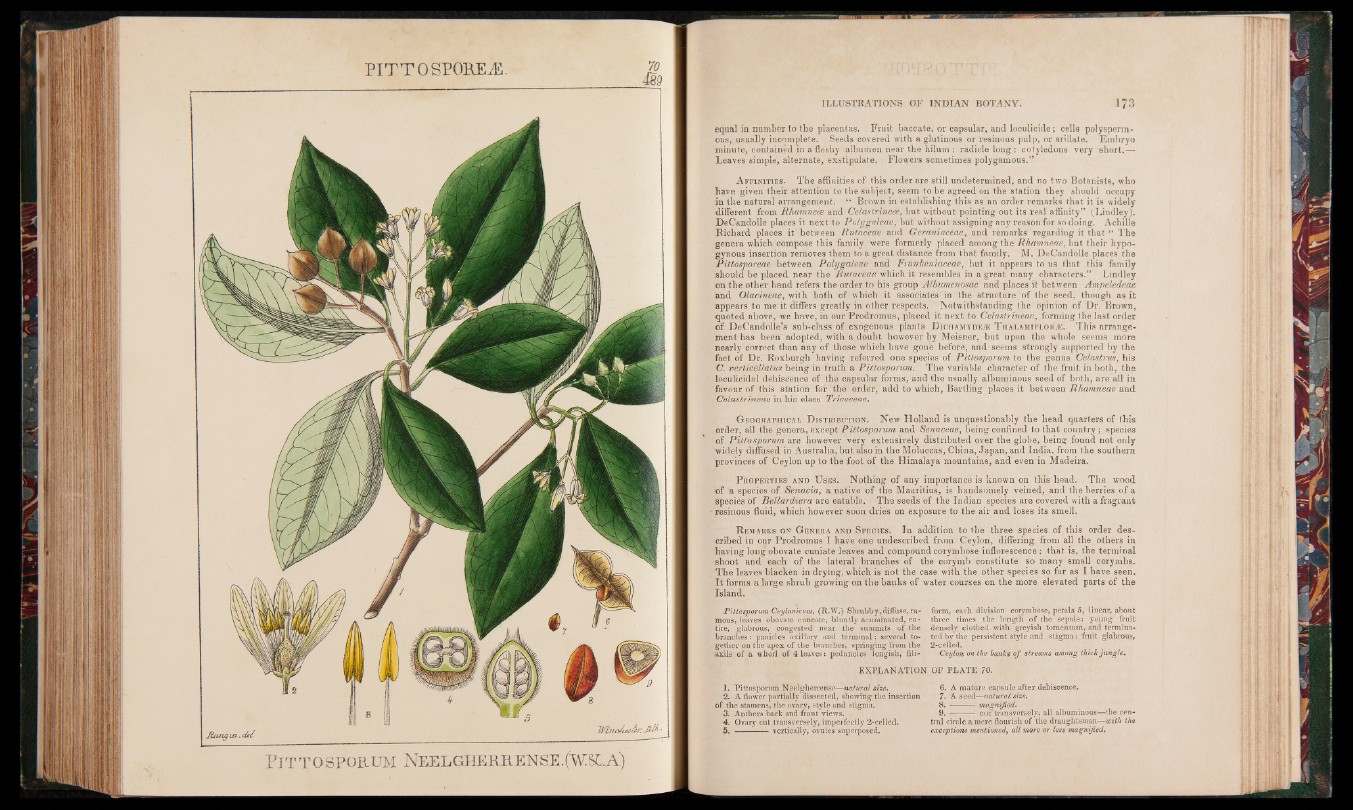
P ITTO S POR EÆ. 70
P it t o s p o r u m N e e l g h e r r e n s e .(w:sc.a )
equal in number to the placentas. Fruit, baccate, or capsular, and loculicide; cells polysperm-
ous, usually incomplete. Seeds covered with a glutinous or resinous pulp, or arillate. Embryo
minute, contained in a fleshy albumen near the hilum : radicle long : cotyledons very short.—
Leaves simple, alternate, exstipulate. Flowers sometimes polygamous.”
A ffinities. The affinities of this order are still undetermined, and no two Botanists, who
have given their attention to the subject, seem to be agreed on the station they should occupy
in the natural arrangement. “ Brown in establishing this as an order remarks that it is widely
different from Rhamnece and Celastrineae, but without pointing out its real affinity” (Lindley).
DeCandolle places it next to Poly galeae, but without assigning any reason for so doing. Achille
Richard places it’between Rutaceae and Geraniaceae, and remarks regarding it that “ The
genera which compose this family were formerly placed among the Rhamneae, but their hypo-
gynous insertion removes them to a great distance from that family. M. DeCandolle places the
Pittosporeae between Polygaleae and Frankeniaceae, but it appears to us that this family
should be placed near the Rutaceae which it resembles in a great many characters.” Lindley
on the other hand refers the order to his group Albumenosae and places it between Ampeledeae
and Olacineae, with both of which it associates in the structure of the seed, though as it
appears to me it differs greatly in other respects. Notwithstanding the opinion of Dr. Brown,
quoted above, we have, in our Prodromus, placed it next to Celastrineae, forming the last order
o f DeCandolle’s sub-class of exogenous plants D ichamyde® T halaMiflor®. This arrangement
has been adopted, with a, doubt however by Meisner, but upon the whole seems more
nearly correct than any of those which have gone before, and seems strongly supported by the
fact of Dr. Roxburgh having referred one species of Pittosporum to the genus Celastrus, his
C. vefticellatus being in truth a Pittosporum. The variable character of the fruit in both, the
loculicidal dehiscence of the capsular forms, and the usually albuminous seed of both, are all in
favour of this station for the order, add to which, Bartling places it between Rhamneae and
Celastrineae in his class Tricoceae.
G e o g r a p h ic a l D i s t r ib u t io n . New Holland is unquestionably the head quarters of this
order, all the genera, except Pittosporum and Senaceae, being confined to that country; species
of Pittosporum are however very extensively distributed over the globe, being found not only
widely diffused in Australia, but also in the Moluccas, China, Japan, and India, from the southern
provinces of Ceylon up to the foot of the Himalaya mountains, and even in Madeira.
P r o p e r t ie s a n d U s e s . Nothing of any importance is known on this head. The wood
of a species of Senacia, a native of the Mauritius, is handsomely veined, and the berries of a
species of Bellardiera are eatable. The seeds of the Indian species are covered with a fragrant
jresinous fluid, which however soon dries on exposure to the air and loses its smell.
R em a r k s o n G e n e r a a n d S p e c i e s . In addition to the three species of this order described
in our Prodromus I have one undescribed from Ceylon, differing from all the others in
having long obovate cuniate leaves and compound corymbose inflorescence : that is, the terminal
shoot and each of the lateral branches of the corymb constitute so many small corymbs.
The leaves blacken in drying, which is not the case with the other species so far as I have seen.
It forms a large shrub growing on the banks of water courses on the more elevated parts of the
Island.
Pittosporum Ceylanicum, (R.W.) Shrubby,diffuse, ra- form, each division corymbose, petals 5, linear, about
mous, leaves obovate cuneate, bluntly acuminated, en- three times the length of the sepals: young fruit
tire, glabrous, congested near the summits of the densely clothed with greyish tomentum, and termina-
branches: panicles axillary and terminal; several to- ted by the persistent style and stigma: fruit glabrous,
gether on the apex of the branches, springing from the 2-celled.
axils of a whorl of 4 leaves: peduncles Jongish, fili- Ceylon on the banks of streams among thick jungle.
EXPLANATION OF PLATE 70.
1. Pittosporum Neelgherrense—natural size. 6. A mature capsule after dehiscence.
2. A flower partially dissected, showing the insertion 7. A seed—natural size.
o f the stamens, the ovary, style and stigma. 8. ■ | • magnified.
3. Anthers back and front views. 9. ' .v,:;— : cut transversely» 4. all albuminous—the cen- Ovary cut transversely, imperfectly 2-celled* tral circle a mere flourish of the draughtsman—with the
5. - .....— vertically, ovules superposed. exceptions mentioned, all more or less magnified.